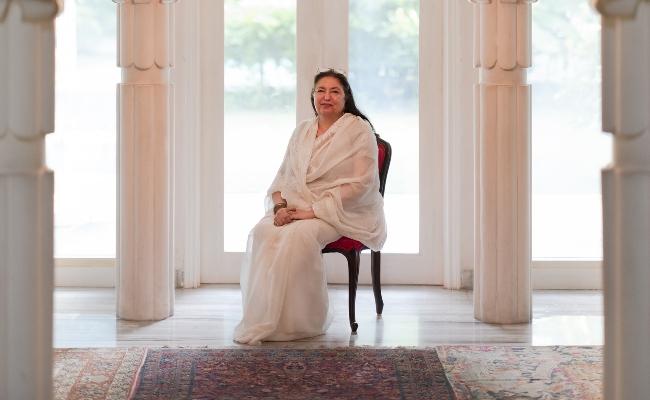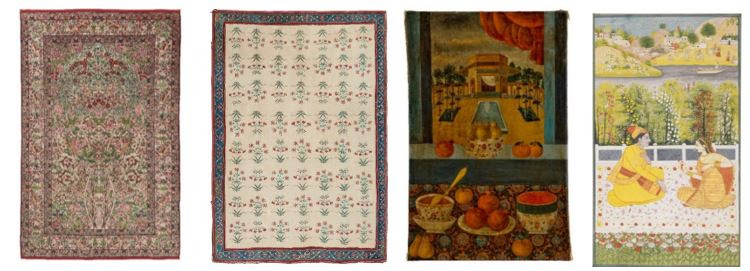Art of the Islamic and Indian Worlds including Oriental Rugs and Carpets

Christie’s announces a collaboration with Founder and Creative Director of Good Earth India, Anita Lal for the upcoming Art of the Islamic and Indian Worlds including Oriental Rugs and Carpets auction, taking place on 31 March. Good Earth is India’s leading luxury design house that celebrates the heritage of the Indian subcontinent and lands that lay on the ancient Silk Road, through unique design stories with a focus on sustainability and craft traditions. Anita Lal has selected her personal highlights from the upcoming sale some of which will be incorporated into three vignettes alongside selected pieces from Good Earth, as part of the view in King Street, London, open from 26 to 31 March.
Anita Lal comments, ‘I am delighted to work with Christie’s on the Art of Islamic and Indian Worlds Including Oriental Rugs and Carpets auction and to have the opportunity to see these remarkable works of art which showcase the skill and craftsmanship over the centuries. The lots that I have selected have enchanted me. The opulent and sumptuous carpets and rugs; the inspirational designs and techniques and the noble provenance across the sale are a reminder of our rich cultural past. For me, the value lies only in an object’s visual and emotional appeal, and I treasure things from the smallest handmade ceramic vase to a grand sculpture or an antique carpet and I mix them all together. Islamic design vocabulary and craftsmanship has been a source of inspiration for many collections at Good Earth and we honor it by creating products rooted in this incredible artisanal heritage in a contemporary context'.
Sale Highlights with thoughts on each by Anita Lal

(Lot 195), (illustrated above top left), A Kurdish long rug, South Caucasus, circa 1880 (estimate £3,000-5,000). ‘This Kurdish rug instantly appeals as it reminds me of vintage Kashmiri kani shawls that have been passed down in my family. It is fascinating to see how ancient patterns were transmitted and reinterpreted, from shawls to carpets and even inlaid in stone’. (Lot 33), (illustrated above), A Mamluk silver-inlaid brass bowl Egypt or Syria, late 13th or early 14th century. (Estimate £15,000-20,000). ‘This bowl conveys beauty and strength, enhanced with fine craftsmanship that balances the overall design with the form of the bowl in perfection’. (Lot 184), (illustrated top right), A Tabriz carpet, North West Persia, circa 1890 of Mughal design, (estimate £8,000-12,000). ‘Van Vaibhav means ‘splendour of the forest’ and is a leitmotif at Good Earth. Blossoming trees with birds and animals is a recurring theme in our designs interpreted so exquisitely in this carpet. There is an uplifting feel of being one with nature’.

(Lot 207), (illustrated above left), A Kirman ‘Millefleurs’ Prayer Rug, circa 1900. (Estimate £3,500-4,500). ‘I love the departure from tradition in this unique Millefleurs rug with its bountiful florals in pastel shades of pink, aqua, blue and leaf green. It transports me to an enchanting blossoming garden’. (Lot 177), (illustrated above second left), An Agra Carpet, North India, late 19th century of Mughal 'Shrub' design (estimate £7,000-10,000). ‘The stylised floral butahs woven into this Agra carpet mirror the butahs carved in marble and inlayed with precious stones on the Taj Mahal in Agra and this is what makes it so unique for me. It tells the tale of precious brocades, carpets, shawls and jewellery produced in the royal Mughal workshops known as Karkhanas. Known for their love of extravagant luxury, the Mughals had an intrinsic sense of aesthetics and a desire for perfection, tempered with extreme refinement. (Lot 66), (illustrated above third left), A still life with fruit and a palace garden. Qajar Iran, first half 19th century. Painting, oil on canvas (estimate £8,000-12,000). ‘The Pomegranate is an integral motif in Eastern cultures symbolizing fertility and abundance. This painting brings to mind our latest dinner collection inspired by the Bosporus and lands around it. Featuring deep ruby pomegranates in playful arrangements across bowls and plates it evoke gardens and promenades in a dreamlike world of wonder like this Qajar oil painting.’ (Lot 94), (illustrated above far right), Radha and Krishna on a terrace Pahari hills, India, early 19th century. Painting and folio (estimate £10,000-15,000). ‘The Pahari miniatures are the most lyrical and romantic Indian paintings. I love the perfect shades of golden yellows balanced with ivory of the dhurrie and of the blossoms along with hints of and pale green and pink. It is a scene of harmony and quiet delight with nature at its most beautiful’.
Behnaz Atighi Moghaddam, Specialist Islamic and Indian Art, and Head of Sale comments, ‘I have been enthused by Good Earth’s contemporary collections and design ethos since discovering them several years ago. I immediately recognised the strong symbiosis in their creative along with the markers of the Indian and Islamic worlds which keeps the legacy of Indian heritage alive and present today. It also recognises the vitally important contribution that Indian and Islamic works of art over the centuries, represented in the Christie’s sale, have made to today’s artists and craftsmanship as seen at Good Earth’.
The Art of the Islamic and Indian Worlds including Oriental Rugs and Carpets comprises 211 lots in total, with striking examples of works of art across manuscripts, paintings, ceramics, metalwork and carpets dating from the 9th to 19th century, and with estimates ranging from £2,000 to £2,500,000, with the sale being held on 31 March. The Art of the Islamic and Indian Worlds including Oriental Rugs and Carpets exhibition and view will take place at Christie’s King Street, from 26 March – 31 March.





